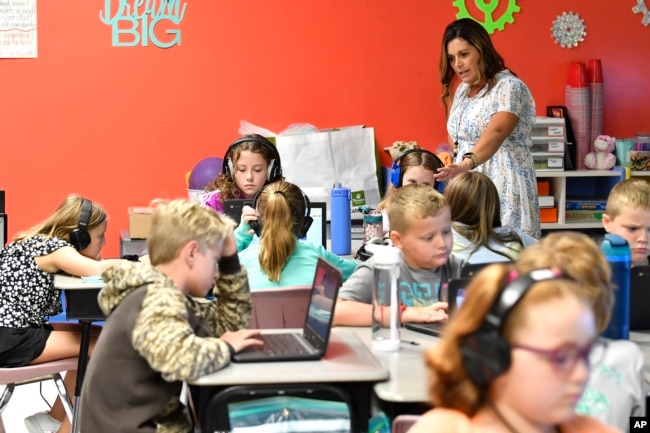Are US Schools Doing Enough for Mental Health?

For 9-year-old Leah Rainey, the school day now begins with what her teacher calls an “emotional check-in.”
“It’s great to see you. How are you feeling?” a voice comes from her laptop. It asks her to choose an emoji that represents how she feels: Happy. Sad. Worried. Angry. Frustrated. Calm. Silly. Tired.
Depending on her answer, Leah gets a few more questions: Have you eaten breakfast? Are you hurt or sick? Is everything okay at home? Is someone at school being unkind?
On a recent day, Leah chose “silly.” But she said she struggled with sadness during online learning.
Leah is in the fourth grade at Lakewood Elementary School in the American state of Kentucky. This year, all 420 students there will start their days the same way. The school is one of thousands across the United States using technology to measure students’ state of mind and warn teachers of anyone who might be struggling.
The tool that Leah Rainey and other Lakewood students use for “emotional check-in” is called Closegap. Rachel Miller is the founder of Closegap. She said interest in the technology exploded because of the coronavirus pandemic. She said more than 3,600 American schools will be using the technology this year.

Angela Pike watches her fourth grade students at Lakewood Elementary School in Cecilia, Ky., as they use their laptops to participate in an emotional check-in at the start of the school day, Thursday, Aug. 11, 2022. (AP Photo/Timothy D. Easley)
Disagreement over social-emotional learning
In some ways, this year marks a return to pre-pandemic normalcy in the U.S. Most school systems have lifted face-covering requirements. Most have also ended social distancing rules. But the pandemic’s long-lasting effects remain. Among them are the effects of loneliness and distant learning on children’s emotional well-being.
School systems across the country are using federal pandemic money to hire more mental health specialists. They are also using the money to expand classes that deal with emotional health.
The class, called social-emotional learning, or SEL, has become the latest area of disagreement in education.
Some American parents say SEL classes are used to teach ideas about race, gender and sexuality. And they take time away from the more traditional classes.
Asra Nomani is a parent from Fairfax County in Virginia. She said, “Social-emotional well-being has become an excuse to intervene in the lives of children in the most intimate of ways that are both dangerous and irresponsible.”
But educators say the class helps students deal with pressure and emotions. And it will help them in the classroom and life.
Dan Domenech is the executive director of the national School Superintendents Association. He said, “We are finally beginning to recognize that school is more than just teaching the kids reading, writing and arithmetic.” Just as a hungry child cannot learn, Domenech added, a child with a troubled mind cannot pay attention to schoolwork.

A man paints a mural of a giant moon over mountains during construction of University High School's Well Space in Irvine, Calif., on July 28, 2022. When school starts, the room is to be staffed full-time with a counselor or mental health specialist. (AP Photo/Eugene Garcia)
Have we done enough?
A recent report by the U.S. Centers for Disease Control and Prevention found that 44 percent of high school students said they experienced “feelings of sadness or hopelessness” during the pandemic.
President Joe Biden’s administration recently announced over $500 million in assistance to expand mental health services in the country’s schools. The money is in addition to federal and state money that schools have received to deal with pandemic-related needs.
Claire Chi is an 11th-grade student at State College Area High School in central Pennsylvania. She described the government’s efforts as “temporary.” Last year, her school added emergency counseling and therapy dogs, among other supports. But most of that help lasted a day or two, Chi said.
That’s “not really a mental health investment for students,” she said. This year, her school has added more counselors and plans mental health training for all 10th graders.
Many schools, however, are having trouble hiring counselors.
Goshen Junior High School in northwest Indiana has been struggling to replace a counselor who left last year. Jan Desmarais-Morse, one of two counselors left at the school, said, “One person trying to meet the needs of 500 students? It’s impossible.”
The American School Counselor Association recommends having one counselor for every 250 students. But few states in the country have that. For the 2021 school year, only two states — New Hampshire and Vermont — met that goal. That information is based on data from the National Center for Education Statistics.
The Associated Press found that some states have a very low number of counselors: Arizona averages one counselor for every 716 students. In Michigan, it is one for every 638 students. And in Minnesota, it is one for every 592 students.

Statuettes of meditating monkeys sit on a table at Venado Middle School's Well Space in Irvine, Calif., on July 28, 2022. Districts across the country are using federal pandemic money to hire more mental health specialists, rolling out new coping tools and expanding curriculum that prioritizes emotional health. (AP Photo/Eugene Garcia)
Words in This Story
emoji - n. digital image used to express an idea, emotion, etc..
hire - v. to give work or a job to someone
gender - n. a person's own sense of being male, female, some combination or neither
intimate - adj. very personal and private
arithmetic - n. a branch of math that deals with numbers and their addition, subtraction, multiplication and division
https://learningenglish.voanews.com/a/are-us-schools-doing-enough-for-mental-health-/6709175.html